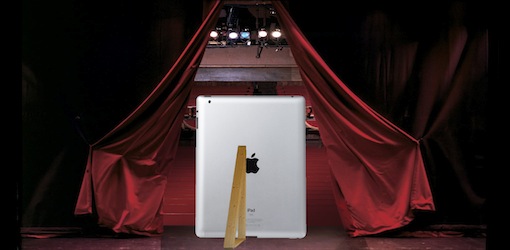The Threat of Resolution
Posted on October 25, 2012 | posted by:
Live performance has brought people together since the beginning of civilization; captivating our imaginations, provoking thought and inspiring change. It is a celebration of the mystery, beauty, tragedy and triumph of our humanity and to be part of the audience is to share in one of our most honored traditions. Over the last two centuries, technology has played an increasingly significant role in this relationship between audience and stage. Even with the advent of the camera, both suspicion and intrigue have surrounded the technology we use to interpret the human experience and its incorporation into performance and visual art mediums stirs constant debate. In a traditional sense, the stage offers us unique experiences, social commentary, entertainment, or, as Shakespeare’s Hamlet suggests, a “mirror” in which we can examine our true selves. I see in this reflection not only ingenuity and amazement but also lust, arrogance, and an unabated infatuation with technology. It seems already apparent that the increasing availability of these new technologies has undermined their necessity in the first place. In the world of performance, this has led to a canon of work that more and more resembles what we see on our screens.
I recently saw Amon Tobin’s ISAM at the Hammerstein Ballroom in New York. This prolific artist has continued to make substantial contributions to electronic music since 1996 but his current tour’s success may actually have more to do with its visual component. ISAM incorporates new innovations in digital video mapping that essentially wrap high-resolution video around a three dimensional set while allowing it to be perfectly synced to the music at all times. On a stage roughly 40’ wide, a massive tower of stacked, white cubes is used as a projection surface throughout the show. Though fixed in place, the video animations create an impression that the boxes are constantly morphing and shifting with the content. The video mapping software conforms and scales the video to the various surfaces of the cubes, greatly expanding the perceptual depth of the image. Gizmodo, the popular publication for digital gadgetry and culture, has dubbed the event, “The Concert of the Future, Today.” Occasionally, Amon Tobin can be seen at the turntables in the center of the cubes but only when he de-activates the smart glass that turns his otherwise opaque cube translucent. After one of these moments my wife turned to me and said, “The video is awesome but I really love when I can see him.” It was at that moment when I realized how fickle our suspension of disbelief really is. His apparent “realness” was merely a matter of resolution. My production experience has taught me that a performance of this scale typically requires dozens of people to support it. However, this project clearly demonstrates technology that would allow performances to be run automatically – dare I say artificially – with no human intervention.
I felt like I had just had a glimpse off the precipice of reality and the frightening image I saw staring back was a glossy, high-resolution representation of myself. This was slightly upsetting.
A live music concert offers an opportunity to see, first-hand, a master at work in a never to be repeated, potential performance of a lifetime. We immediately equate “live” with “real” and feel deeply cheated when we find out that technology had intervened (remember Milli Vanilli?). What makes each live experience valuable and unique is its humanness – the improvisations, the “feeling-it-out,” and the mistakes. This, I suppose, is the catalyst for our rare glimpse of Amon Tobin behind the technology curtain. It reassures us that we haven’t totally given over to the machine, but only because we believe he is “real.” If it was not for those few moments, we could have easily been watching a show operated by robots. This reframing of “reality” has wide and serious implications throughout the live performance context. The threat of resolution is a precursor to that of singularity; the danger lies in our obliviousness.
Regardless of the medium, I do believe that the community aspect of gathering in a theater or venue to collectively participate in a viewing experience may save us from the otherwise black hole of solitary screen watching. And in that vein, perhaps it is quite necessary that artists mimic the digital experience so that we can build the tools to confront this conditioning. Recently, there have been several incredibly popular performances that have incorporated almost exclusively software-generated imagery as content for the visual design on stage. Notable examples include the Australian dance company, Chunky Move, and Robert LePage’s La Damnation de Faust at the Metropolitan Opera. These productions used an interactive video technology to allow the projections to respond to human performers on stage. The projections are not meant to portray real scenery; they are unapologetically digital, and therefore rely on a certain technological literacy from the audience. We are becoming accustomed to the gross attention these new environmental actors demand in the conceit of a production but we seem to be sacrificing the narrative and obscuring the human. Perhaps we are simply following our natural techno-curiosity but the question remains: are we asking what technology can reveal about who we are, or just what we can do with it? When resolution upstages humanity that line we perceive between “real” and “artificial” grows increasingly thinner. We may not recognize the moment it disappears.
I think there’s a common goal now where everyone is trying to achieve the effect of a singular system where all devices are in communication working as a singular system. We’re eliminating technical boundaries where something might look as if it’s on its own operational system and not quite doing the same things as another element. So yeah, I think there’s some common ground there between all these different projects to create the effect of a singular system.
– Bryant Place (Derivative programmer for ISAM) – http://www.derivative.ca/Events/2011/AmonTobinVSquared/
